A. Lange & Söhne’s Long-Awaited Odysseus Smart Casual Stainless Steel Watch: Extreme Details, Thoughts, Live Photos, And Wristshots
It was an odyssey taking A. Lange & Söhne through the last 12 years. A journey that for me puts into question whether it was really the journey or the destination that was the goal.
“Der Weg ist das Ziel” we would say in German: the journey is the destination.
Journeys like this are the stuff that A. Lange & Söhne is made of: emerging from behind the steely iron curtain of East Germany precisely 25 years ago to this day after more than 40 years of forced retirement, you can say that this brand has really come through more than one odyssey in the truest sense of the word.
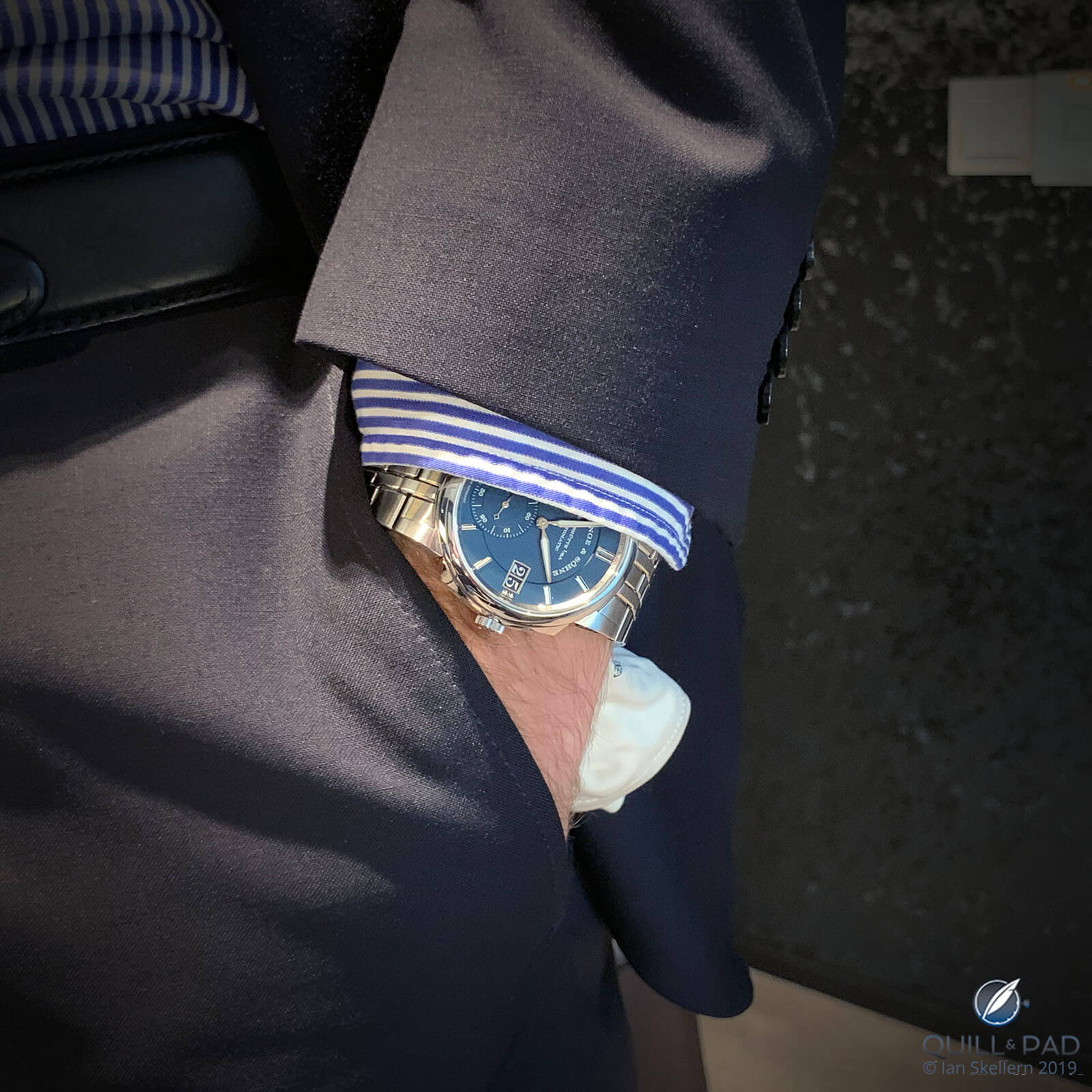
A. Lange & Söhne Odysseus on the wrist
But while Homer’s eponymous Greek legend saw the hero Odysseus needing ten years for his journey home from Troy after being away for ten years’ worth of war, the designers and watchmakers under the direction of A. Lange & Söhne’s head technician Anthony de Haas needed 12 years from the day the brand made the decision to acquiesce to the most fervent wishes of its loyal collecting public.
The big O: the culmination of a long wait
The Odysseus is the culmination of both a transformative journey for Lange and a watch that collectors and connoisseurs of the brand have been wanting, waiting for, dreaming about, and clamoring for since the brand was re-founded in 1994: a daily wearer by A. Lange & Söhne in hardy stainless steel.
The introduction of the Odysseus is the climax of the wishes that clients, customers, and collectors have transmitted to the powers that be at A. Lange & Söhne.
A. Lange & Söhne has never before offered serial stainless steel as an option – the other five lines in the elegant Saxon brand’s collection just don’t have the same level of ability to be worn in everyday situations.
“A request for a watch like this has been so loud for the last ten years and more that Tony and the team worked on it for over a decade,” confirmed A. Lange & Söhne CEO Wilhelm Schmid.
The first attempt was undertaken 12 years ago. Once this iteration was determined to be the one, the team worked on it with dedication for four years.
A. Lange & Söhne’s last stand: stainless steel
Longtime fans of the Saxon brand might be gratified to know that even co-refounder and creative, visionary tour de force Günter Blümlein – who passed away in October 2001 at the age of 58 – left behind ideas for a Lange sports watch in his notes and archives.
While de Haas explained that there were no illustrations or sketches included, there were plenty of names and concepts, perhaps the most entertaining one being the working title “Zeiteisen” (a contrived compound word involving “iron/steel” + “time”).
Until now, A. Lange & Söhne’s only steel watches have been the very secretive special editions about which very little is known. They are so rare that anyone who has actually seen one can be counted an insider. Today, the rare-as-hen’s-teeth stainless steel examples are the most sought-after collector’s pieces made by A. Lange & Söhne.
In fact, in The Value Of Rarity: Christie’s Auctions A Black-Dialed A. Lange & Söhne Lange 1 In Stainless Steel, GaryG states that there are perhaps only 25 stainless steel watches of any kind by A. Lange & Söhne in circulation. A. Lange & Söhne isn’t saying, and there is a lot of speculation, so that’s the number I would stick with based on a conversation I had in 2017 with Fabio Bertini, once head of Milan’s Pisa Orologeria, an early supporter of the Saxon brand.
“When A. Lange & Söhne was re-founded in the 1990s, Pisa Orologeria was one of the first retailers to believe in their rebirth,” Bertini confirmed to me in 2017. “Therefore, at the time I had an ongoing working relationship with Günter Blümlein and I initially proposed to make a Lange 1 in stainless steel. His reply was very rational: he explained to me that the different case material wouldn’t have generated any change in terms of price from the gold-encased version. But my motive wasn’t related to price, I was tickled by the idea of having a steel version of a product usually crafted in gold – this was something outside the box, especially considering it contained an important complication inside. And Mr. Blümlein accepted my offer.”
By the mid-1990s, Bertini and Blümlein had together created the handful of stainless steel specialties. These watches are so underground and, well, mythical that it is still difficult to find information about them. The now-retired Bertini confirmed to me that Pisa purchased about 20 stainless steel A. Lange & Söhne timepieces in total.
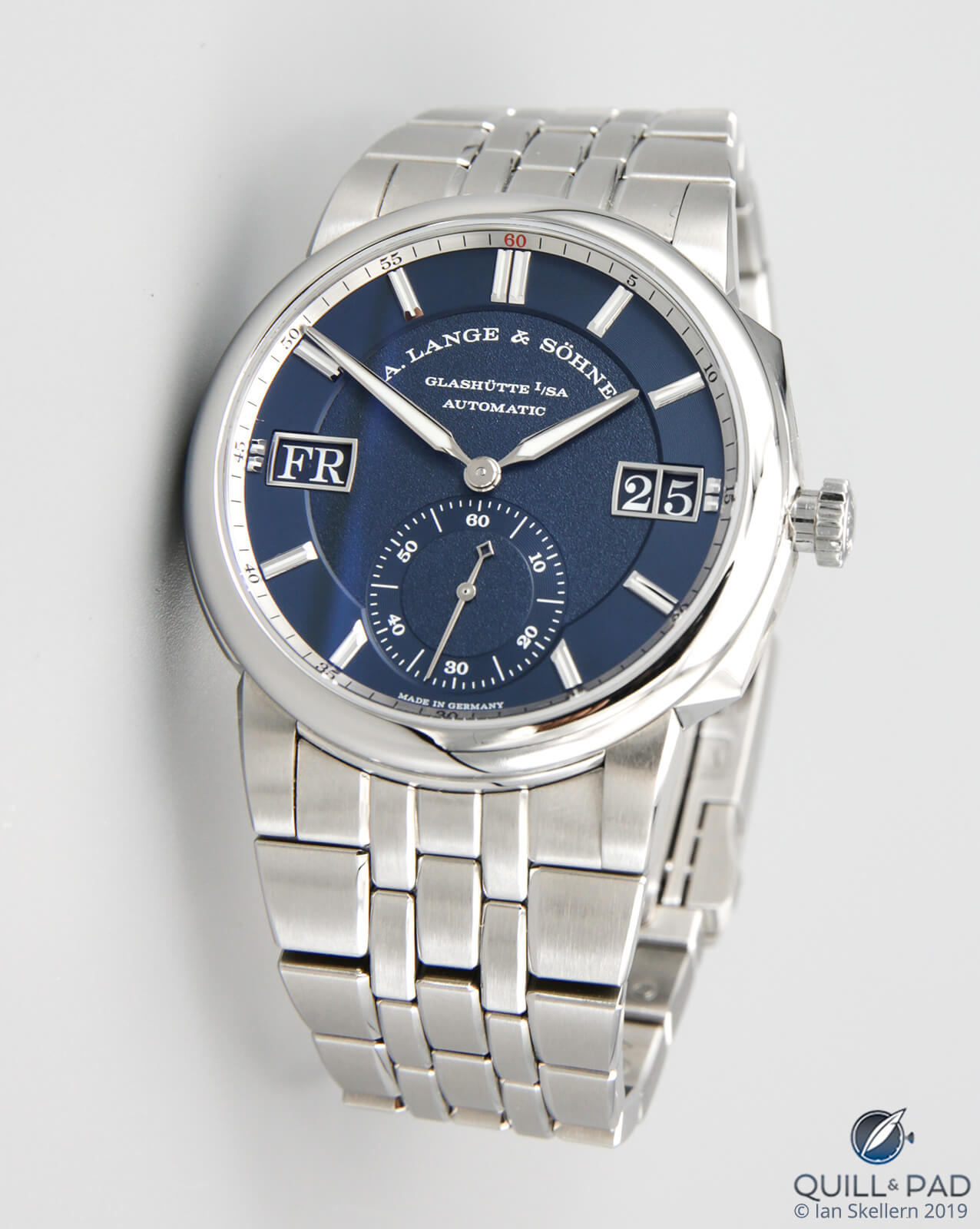
A. Lange & Söhne Odysseus
The Odysseus is the very first serial A. Lange & Söhne watch encased in stainless steel. This in itself makes it an exceptional item worthy of collecting. And wearing.
Mission impossible: a million ways to do it wrong, but few to do it right
Coherence is likely the main theme that A. Lange & Söhne’s technicians and designers had to grab by both horns to ensure this product would become neither a “me too” watch nor a “wannabe” timepiece. They have succeeded.
So I asked de Haas what the most important elements were during the core development. His answers were not so unexpected (and reproduced here in the order he listed them to me):
1. Not to copy Audemars Piguet or Patek Philippe.
2. To find a face that fits the brand.
3. Functionality.
Let’s start with number one: not to copy what has come before in this now hotly contested genre, one that was unarguably invented when designer Gérald Genta was tasked with coming up with a brand-new, “unprecedented” wristwatch only 24 hours before a meeting with Audemars Piguet said to make or break the brand’s future. Genta grasped the word “unprecedented,” which he combined with “water resistance,” though what was actually needed was a brand-new all-purpose wristwatch reflecting a more contemporary lifestyle.
The Audemars Piguet Royal Oak, which launched in 1972, contained two elements that became instantly characteristic of this ultra-successful line – so successful that today it strongly overshadows all of the brand’s collections: the octagonally shaped bezel secured by eight now iconic screws and the watch industry’s first integrated bracelet, which even boasted tapering links and exquisite polishing to reflect light across its length.
The Royal Oak changed the watch industry’s feel for luxury timepieces in the 1970s, a tectonic shift that not only caused every other major manufacturer to follow suit with their own luxury sports watches in steel (an unimaginably large percentage of which were also designed by independent designer Genta in those days) but also helped to usher in the modern, casual feel for luxury watches we are familiar with today and no longer find unusual, shocking, or even particularly out of place for an expensive timepiece.
The Patek Philippe Nautilus followed in 1976 and the Vacheron Constantin 222 in 1977 – and with that the “big three” each had a stainless steel luxury sports watch in their collections, reflecting the dawn of a new era for the mechanical wristwatch.
While each of these three have their own personalities, and continue to do so (the 222 morphed into the more attractive and modern Overseas in 1996), further brands bringing out luxuriously priced, stainless steel wristwatches with high(er) water resistance and integrated bracelets must often endure cries of less originality (take Girard-Perregaux’s Laureato, for example, which even I find has too much similarity with the Royal Oak, though others disagree).
And, as an interesting aside, in the 1970s all three of these major stainless steel contemporaries shared one movement: called Caliber JLC 920 in its home factory, it was Caliber 1121 at Vacheron Constantin and Audemars Piguet and known as Caliber 28-255 in the Patek Philippe Nautilus. Jaeger-LeCoultre’s base movement for all three of these 1970s luxury sports watches remained in place until the mid-1980s. That last bit has no bearing on this discussion, but it is an interesting fact.
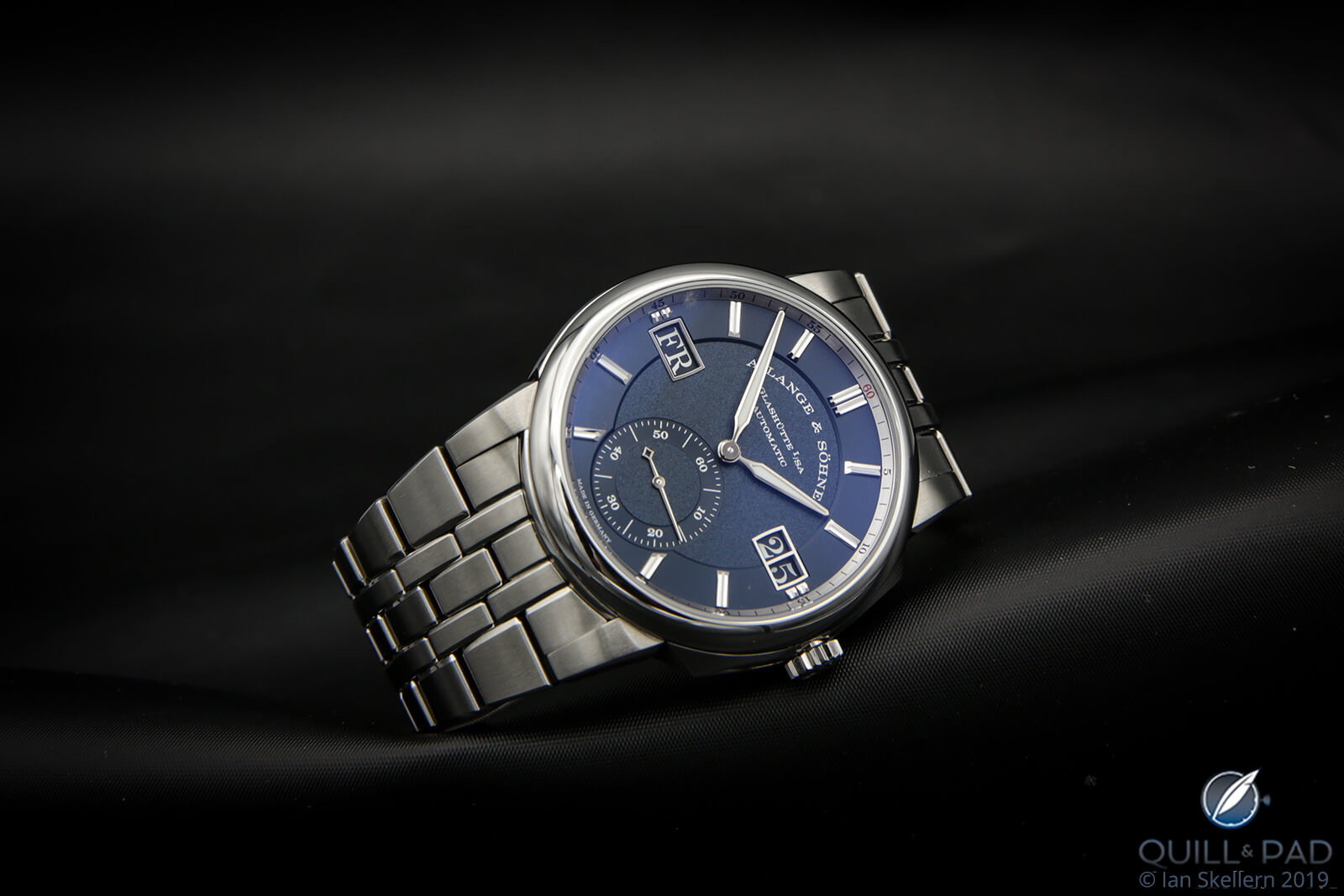
A. Lange & Söhne Odysseus
So did A. Lange & Söhne realize de Haas’s goal of not copying others already in this genre? Indubitably yes.
Aside from the obvious (stainless steel, round case, integrated bracelet), this watch looks nothing like anything else out there with the same attributes – but it does bear an unmistakable family resemblance to the Saxon brand’s other timepieces.
Finding a face to fit the brand and functionality – de Haas’s other two important points – go hand in hand in my book. A. Lange & Söhne has always been a “form follows function” kind of brand in fine German tradition.
But the Odysseus, of course, is something else: functionality is already guaranteed by the fact that it’s a watch meant for activity and leisure time, including sweating, freezing, running, jumping, and splashing – whatever human beings do in a normalish day, even on the weekends or vacation.
So when A. Lange & Söhne set out to breach this category, functionality was going to be the uppermost thought. But I understand what he meant by finding the face to match it: in true A. Lange & Söhne tradition, this watch had to offer just a bit more than time and date (as the others did with their freshman releases). And here, again, it had to make sense.
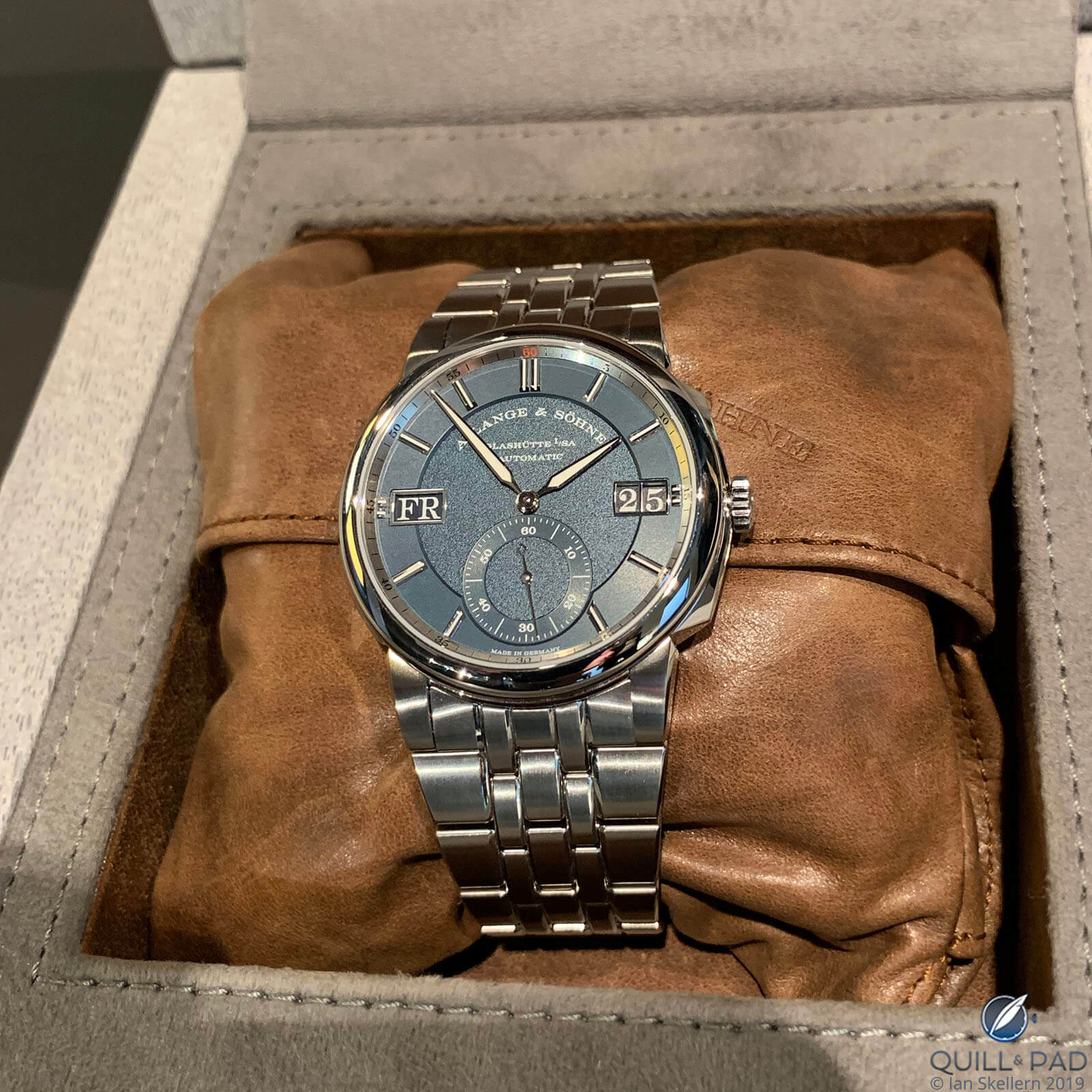
A. Lange & Söhne Odysseus nestled in its case, wrapped around a leather traveling pouch that is included
Including large windows for both the day and the date not only provides more useful information to the wearer, they also allowed the designers more details to use for symmetry purposes. The windows, which hark back to the Lange 1’s large date (a look that has been used liberally throughout A. Lange & Söhne’s relatively short modern history – even on the Zeitwerk), also ensure the family resemblance so important to an all-new approach such as this.
Caliber L155.1 Datomatic for a “brand-new all-purpose wristwatch reflecting a more contemporary lifestyle”
A. Lange & Söhne could easily have used another movement from its range here. But that would have put it in a decided league with Patek Philippe’s Nautilus, which encases an existing movement used elsewhere in the Genevan brand’s collection.
The Sax-O-Mat Caliber L921, introduced in the brand’s first automatic watch, the Langematik of 1997, might have been a candidate to power this watch except for its lower frequency of 3 Hz (21,600 vph), which makes its rate a bit more susceptible to shocks, and its micro (three-quarter) rotor, which keeps the case height down but provides a bit less stability.
Though the Lange 1 Daymatic’s rotor is full-sized, Caliber L021 is still set up for elegance over extreme stability as evidenced by its frequency of 3 Hz (21,600 vph).
“[Making] this movement is still hugely challenging at this price,” de Haas confirmed, speaking of the new Caliber L155.1 Datomatic. “But it was more important for us to create a watch that is us than to create something else. Sure, we could have used the Sax-O-Mat . . .”
. . . except that Lange does nothing half-assed. Nothing. So it was all or nothing here: if they were gonna do it, then they were gonna do it with an all-new development just for this purpose and nothing else. Like every single watch in this brand’s impressive arsenal.
“Time will tell whether we did this right,” Schmid remarked. “We took no shortcuts, created a new movement and a new case design over what we already have.”
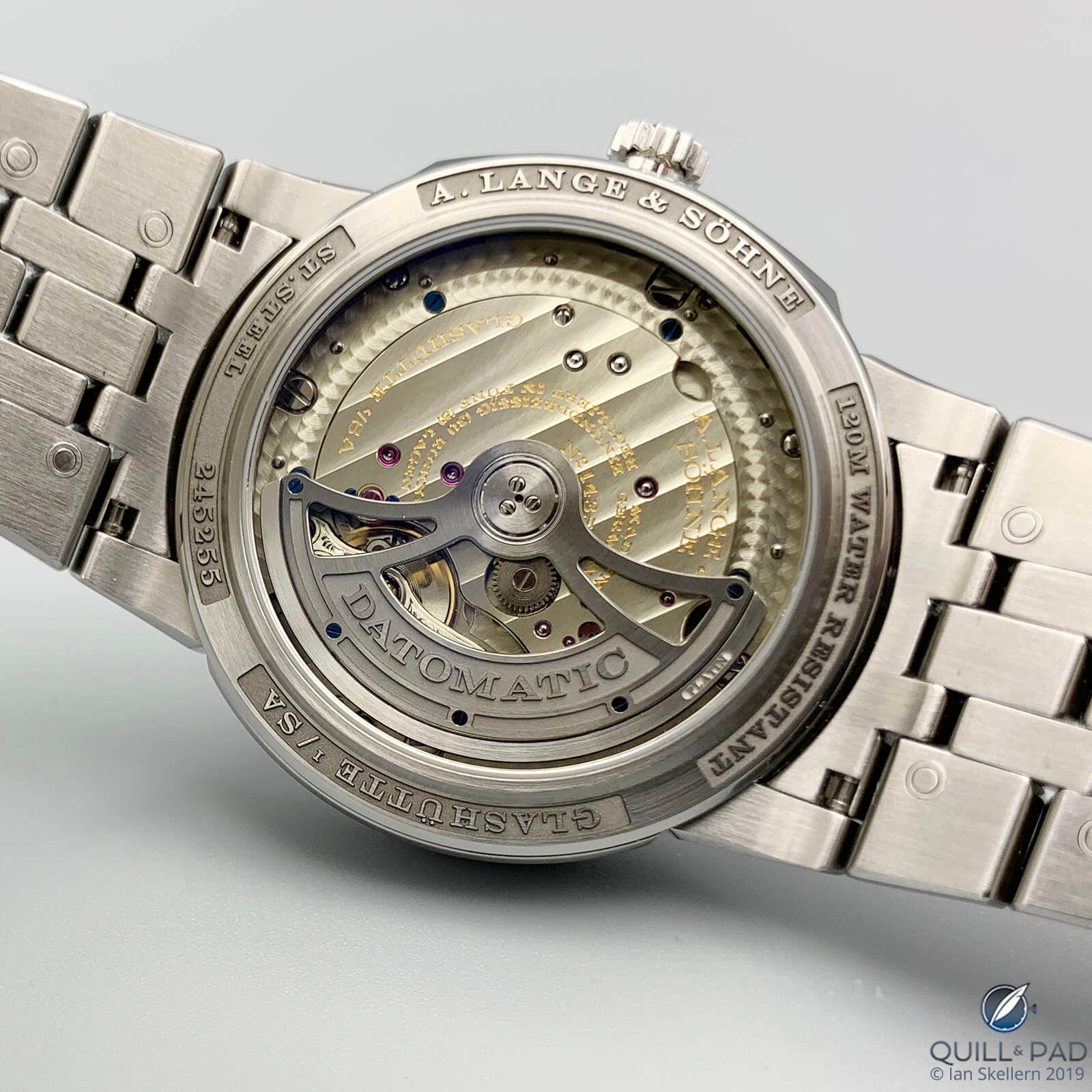
A. Lange & Söhne Odysseus Caliber L155.1 Datomatic movement
This movement is stunning. Caliber L155.1 Datomatic is nothing else if not the exquisite quality we have come to know and love from this German brand. And luckily, we can see it through the sapphire crystal case back of the Odysseus.
The movement is built for more stability. Peering through the back of the stainless steel case, what hits the eye first is a full-sized steel-colored rotor that has been openworked so as to leave as much of the movement on display as possible – a movement that has been assembled twice like any other Lange movement and finished to its eyeballs with what is most likely the best serial movement finishes available today.
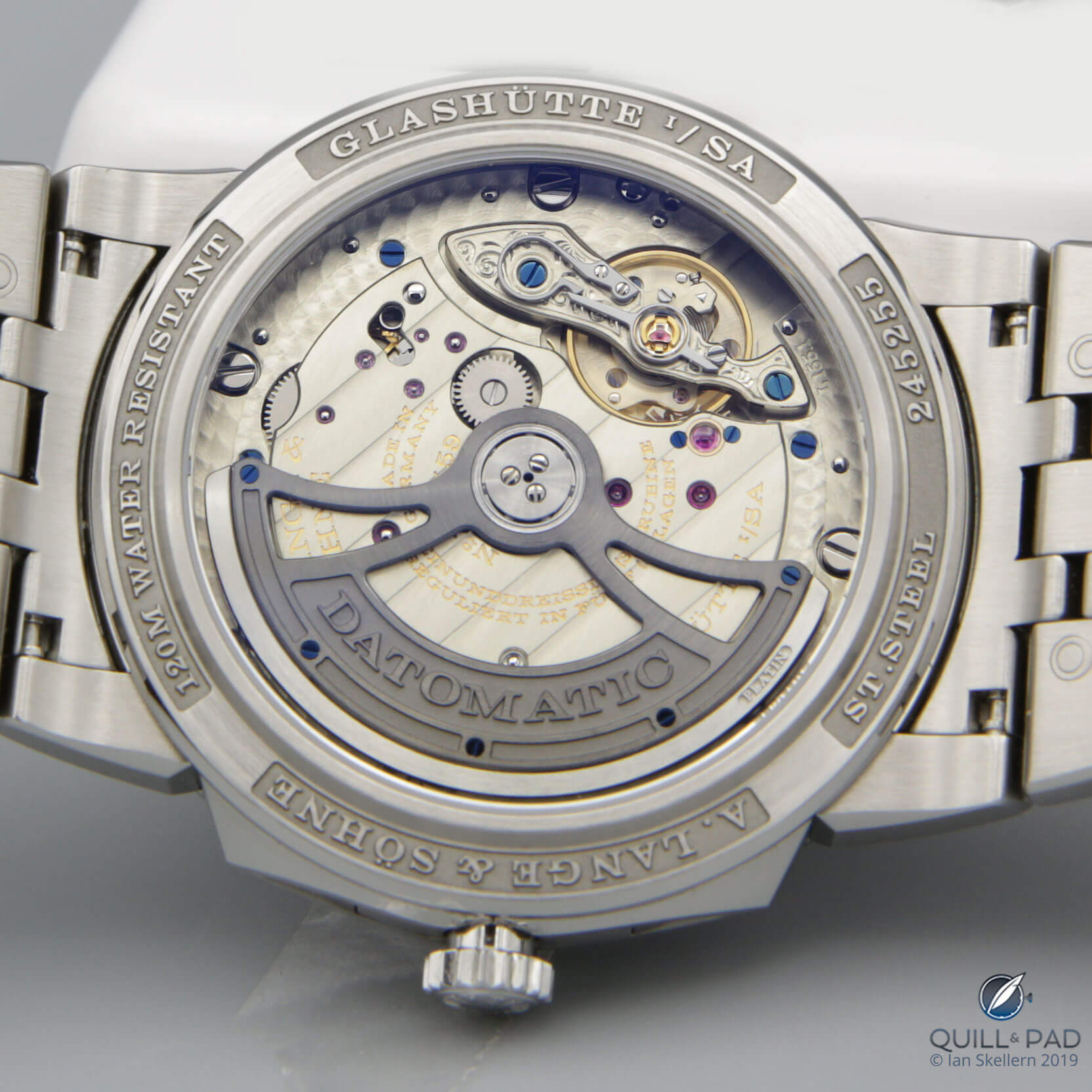
A. Lange & Söhne Odysseus Caliber L155.1 Datomatic movement
The rotor is not stainless steel, but rather ARCAP (for flexibility) with a platinum weight (for weight) – denoted by the engraved word “Platin” on the oscillating weight. Its brushed finish is decidedly modern in keeping with the rest of the watch’s sporty ambiance, while its top plate is almost full-sized in keeping with desire for extra stability. But thankfully it does leave the regulator out for ogling, dominated of course by the hand-engraved balance bridge.
If you follow A. Lange & Söhne, you will already know that the usual hand-engraved balance cock – which differs from the bridge in that it is secured to the plate only on one side – is the foremost component of the movement, immediately capturing the eye. Here, we find an unusually shaped German silver bridge secured to the plate on both sides, ensuring an extra tick of strength in holding the balance and escapement.
Underneath, the freshly designed shock-resistant balance wheel with four poising screws ticks away at a modern four-Hertz pace, another safeguard for a watch destined for an active lifestyle: when the watch is inevitably bumped, the faster pace more readily prevents the balance from being easily knocked out of whack, thereby preserving its precision.
The elegant swan-neck spring and precision beat adjuster likewise aid in precision. And the free-sprung balance spring used here was manufactured right at A. Lange & Söhne’s own factory, one of only a handful of brands with that capability.
The 312-component movement is decorated with a variation on the Glashütte ribbing used in the Saxon town instead of côtes de Genève that boasts slightly wider stripes than usual. The cornflower blue of the screws and ruby red of the bearing jewels beautifully contrast with the warm color of the German silver bridges and plates.
If you look closely, you’ll even find one of the 31 jewels (of the escape wheel arbor) set into a screw-mounted gold chaton paying homage to the haute horlogerie heart of this wonderful timepiece. Nodding at tradition, but not being a slave to it.
And, keeping the look of the whole watch homogenous, the rotor and case back bezel all thoughtfully have the same style of relief engraving.
“This is not an ‘industrialized’ product. The quality is exactly the same as our Lange 1 or anything else,” Schmid promised.
Dial of the A. Lange & Söhne Odysseus
I usually look at a watch’s movement first, but I know that consumers are always attracted by a watch’s looks. So what is they’ll see first? The case, dial, or bracelet?
Let’s just say for the sake of argument that it’s the dial so I can start there.
“We tried out hundreds of variations using existing faces like the Saxonia and Lange 1,” explained de Haas. “But we never made prototypes of them. If the Lange 1 and a Panerai slept together, that’s what you would get in some of those cases – not lovely. Making this watch was such a challenge, so you try everything, keep working, explore, and learn.”
Which explains much of the extreme length of time needed to get this perfect.

Dial of the A. Lange & Söhne Odysseus
The brass dial with dark blue galvanic color that extends to the backgrounds of the day and date windows is three-dimensional and coated with varying surface treatments to underscore this three-dimensionality.
While some people are bound to sigh at the sight of yet another blue dial this year, I say to them: wait just a doggone minute! This is a blue the likes of which you have never seen, a blue with texture and grace. I could not imagine this dial being any other color for the introduction of the Odysseus family.
The displays are also perfectly balanced with the day and date respectively at 9 and 3 o’clock, and the subsidiary seconds across from the obligatory verbiage.
While you might guess that the hour markers are steel like the case and bracelet, rest assured they are not: they are white gold, applied, and notched down the middle to carry just the right amount of luminous substance.
The markers are positioned around their own dial level with snailed background (a decorative element repeated around the perimeter of the subsidiary seconds) that contrasts against the grained surface of the inner dials. And, finally, we come to the minute track, which is placed around the dial perimeter on a steely beveled flange, where the red numeral 60 provides the only non-blue or steel-colored accent.
The luminous hands are in principle the same shape as A. Lange & Söhne’s regular hands, just perhaps a little more exaggerated and prominent to allow better legibility in low-light conditions.
Case and bracelet of the A. Lange & Söhne Odysseus
“We did not want this watch to exceed 40.5 mm,” Schmid admonished. “And we wanted to keep it thin. Also, we had a big emphasis on wearability: the bracelet doesn’t shave arm hair, and, importantly, it is comfortable.”

A. Lange & Söhne Odysseus side on
If you look at this watch – which is water resistant to 120 meters – from the side with the crown, what greets you is perhaps the newest element here, one that cannot be found on any other watch by A. Lange & Söhne: two pushers, one on either side of the elegant screw-in crown (though a thicker crown than found on any other Lange watch), that form a sort of protective crown guard. Here it becomes incredibly obvious that this brand is no slave to tradition or fashion, but rather a forward-thinker.
A. Lange & Söhne is known for its round cases, but the way that these pushers integrate partially into the case gives it a whole new shape, one that is simultaneously special, angular, sporty, and –thankfully – still recognizably Lange. The bezel is thin and the sapphire crystal is large, which opens the dial up more than usual, leaving the impression that the watch is bigger than it is.
“Getting the look of this right included a lot of trial and error,” de Haas explained. “It wasn’t always fun, full of painstaking detail. But that’s who we are.”
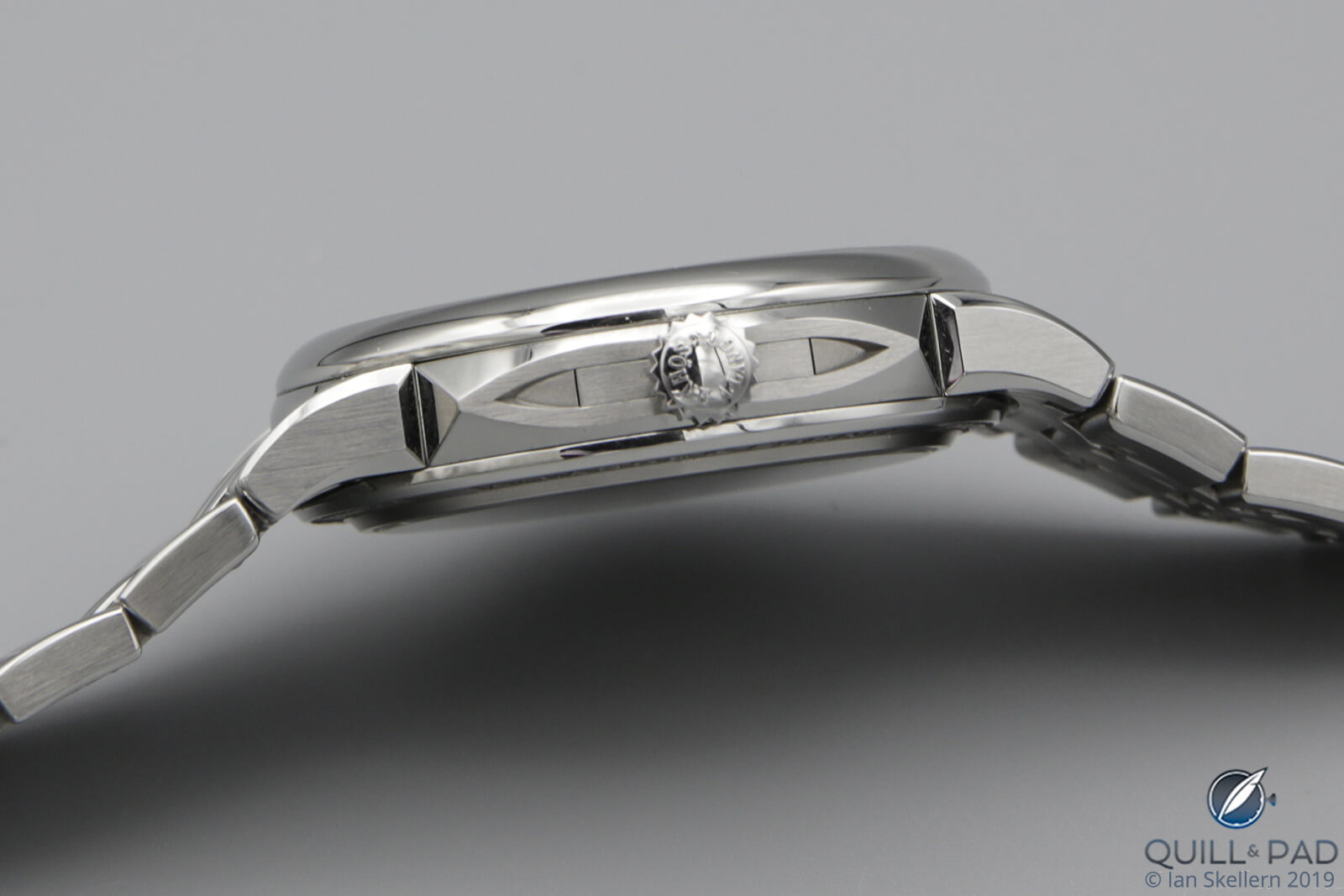
A. Lange & Söhne Odysseus pushers and crown
Then there are the butter-smooth pushers for setting and adjusting the day and date. While the idea for these elements came right from the Lange 1, rest assured these are of a different ilk. “This watch has pushbuttons like no other – no one will be able to copy them so easily,” Schmid explained. “They are totally integrated like a whip, not like a button.”
While this watch needed to be able to go along with most active lifestyles, it also needed to be elegant and sophisticated like any Lange. This case with its integrated bracelet does express where it comes from, but in a reinterpreted way that is particularly obvious in the brand-new bracelet.
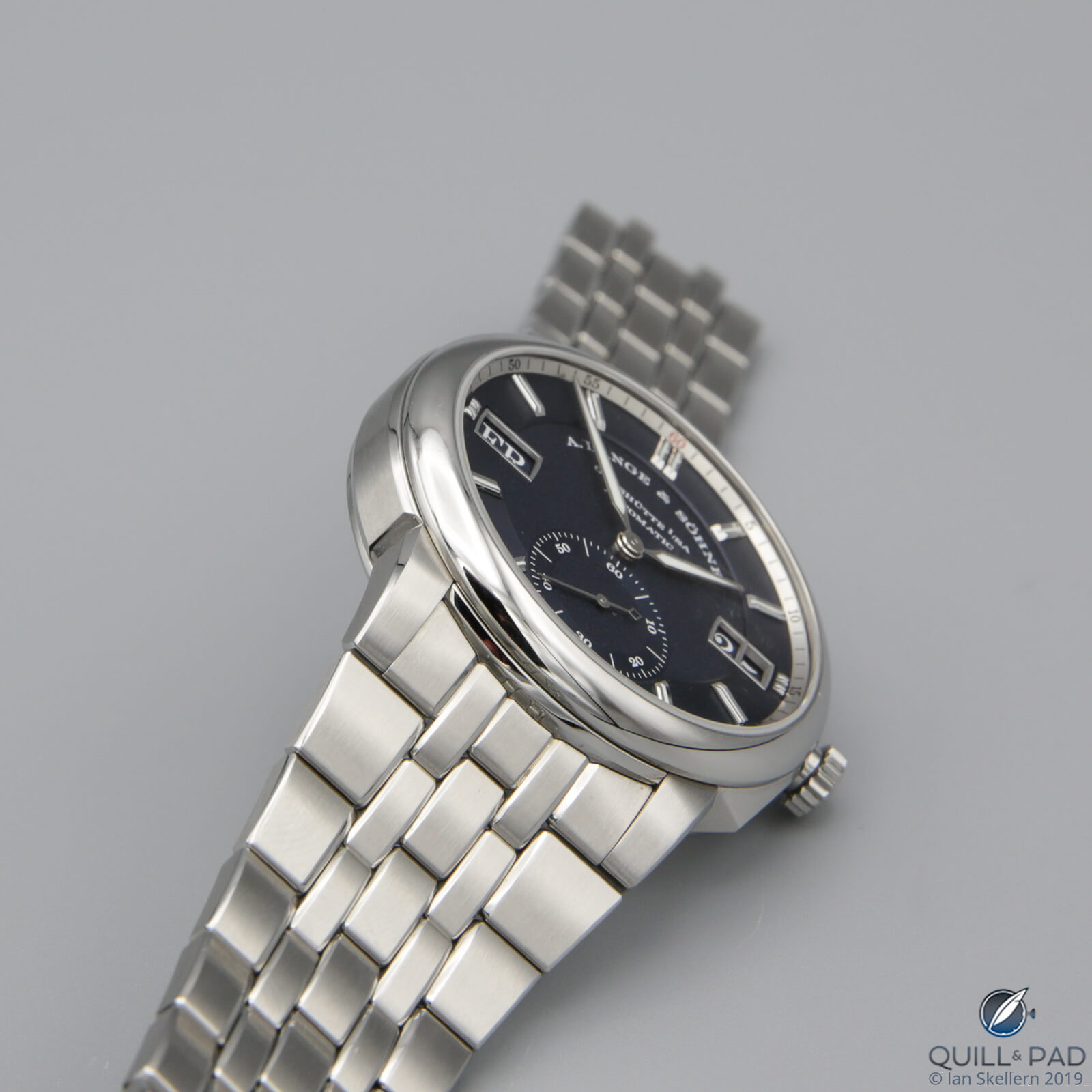
Elegantly flared steel bracelet of the A. Lange & Söhne Odysseus
Just look at the bracelet. It looks silky, smooth, soft, satiny. And I can vouch for the fact that it is all those things with its chamfered edges and brushed surfaces. Adding an extra dose of comfort, its length is adjustable in small steps while on the wrist up to seven millimeters in total.
The bracelet is described by the firm as integrated, but closer inspection reveals that it could be removed if one so desired. Which may mean accessories could be available down the road.
“Odysseus needed decades to come back from Troy; he was successful, but not without pain, struggle, and adventure,” Schmid laughed. “. . . it’s a quest, something that probably – will be – a landmark like the Zeitwerk and the Lange 1. Our idea was to have all the right ingredients to make a family of timepieces.”
Will Odysseus become a modern classic?
“You can really only say in hindsight if something is a classic,” Fabian Krone, then-CEO of A. Lange & Söhne philosophized in 2009 at the launch of the Zeitwerk, which at that time was a not uncontroversial launch in itself. “We couldn’t predict it with the Lange 1; it came with time, and 15 years down the road it remains as fresh as the first day.”
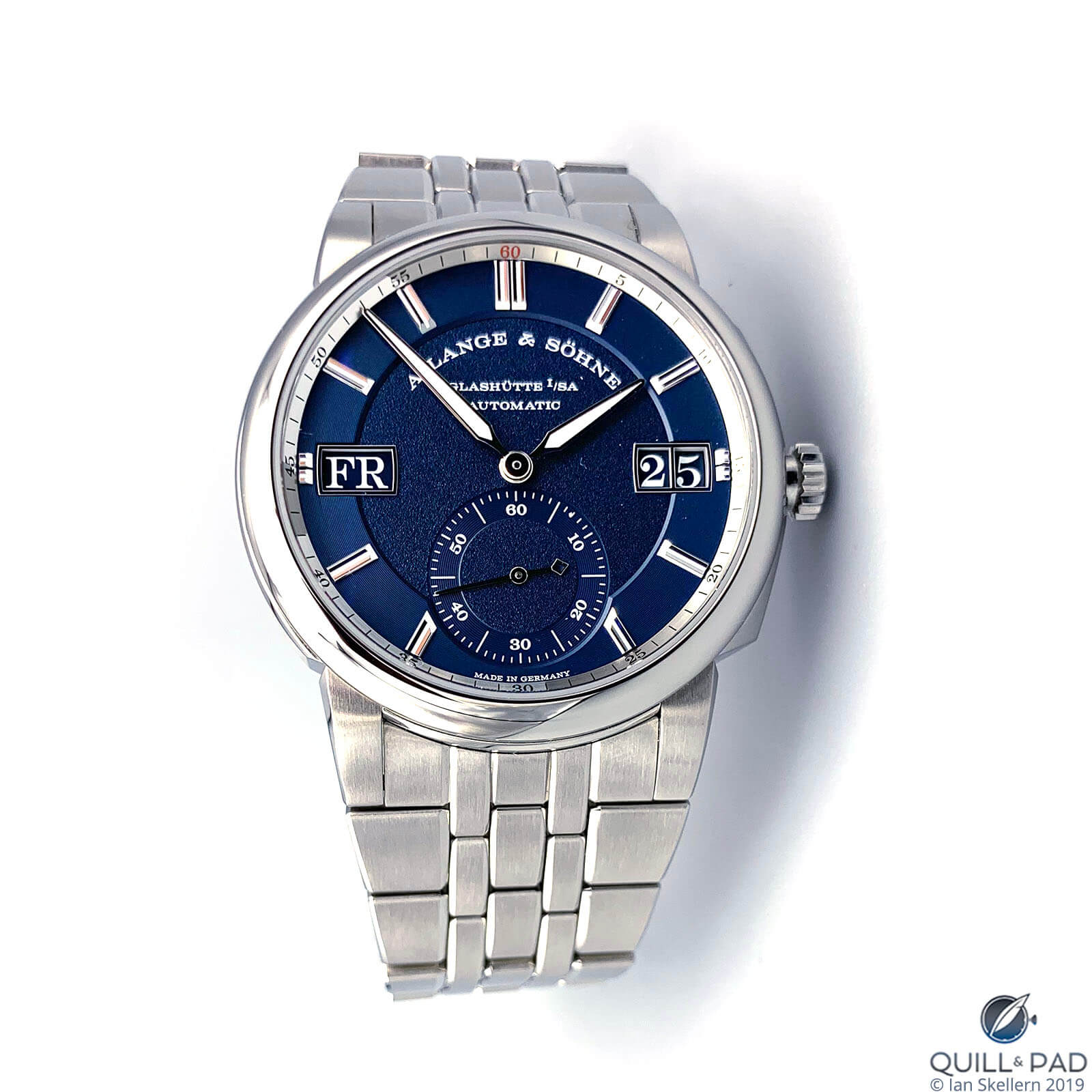
A. Lange & Söhne Odysseus
A. Lange & Söhne, being the cerebral brand that it is, sometimes names its watches in such a way that not everyone gets it right off the bat. “Zeitwerk” is an unusual name even in German, for example. I know no one outside of the German-speaking parts of Europe who can even pronounce it correctly.
The name “Odysseus” unfortunately falls into this category, though I personally understood and loved the name immediately. I’ll be curious to see how it’s received.
A word on the price: so far Lange has only released the home-market euro price of €28,000. This puts the new Odysseus on square footing with the time-and-date Patek Philippe Nautilus in stainless steel . . . which says a lot about the Saxon brand’s ambitions and confidence. In my opinion, justifiably so.
Remember that the Odysseus has an added function (weekday), impossible-to-copy, smooth-as-silk pushers for the two calendar displays, and a brand-new automatic movement (the Nautilus’s movement is used in other Patek Philippe watches).

A. Lange & Söhne boutique in Dresden
However, all of this is not going to keep people from grumbling on the Internet as they do – particularly with the recent introductions of the Bell & Ross BR 05 and Chopard’s Alpine Eagle, both of which feature integrated stainless steel bracelets, though they are all very different watches.
“We have to accept that people will challenge us,” said Schmid. “The worst thing would be no controversial discussion; I expect a lot of it. It makes it lively. Worst case scenario: everybody likes it!”
For more information, please visit www.alange-soehne.com
Quick Facts A. Lange & Söhne Odysseus
Case: 40.5 x 11.1 mm, stainless steel with integrated bracelet
Movement: automatic Caliber L155.1 Datomatic, assembled twice, very finely finished, German silver plates and bridges, hand-engraved balance bridge, 50-hour power reserve, in-house balance spring, 4 Hz/28,800 vph frequency
Functions: hours, minutes, hacking seconds; date, weekday
Price: €28,000
You may also enjoy:
The Mythical Stainless Steel A. Lange & Söhne Tourbillon Pour Le Mérite
Leave a Reply
Want to join the discussion?Feel free to contribute!



Tim, your sources are good.
That’s all I have to say.
The rumors have been flying.
P R O P S … full of respect: only A. Lange & Söhne can do such watches … and only E. Doerr can write such articles. Double Pleasure – Doppeltes Vergnügen.
Vielen Dank!!
Hmmmmm! It’s an A. Lange and this says a lot. I may even try to buy one, but I won’t kill over it. Nice case (although to really make a successful sporty case out of a classic one ask Laurent Ferrier) excellent bracelet; but I spent hours trying to figure out what exactly bothered me! And yes: integrated or not, in my opinion these two remain two! Sorry A. Lange but I feel this should have been launched as a “langeflex” instead and that would have made a hell of a sporty lange.
Agreed…. I think it looks better if it has a non tapered bracelet instead, cz imho it did makes it looks cheap, kinda like a b&r strap. Or throw a vulcanized blue rubber strap. Tbh, it won’t look wrong with a tapered rubber strap either like the design of the bracelet but with this steel bracelet it kinda bothers me a little… Perhaps a steel mesh or a BOR bracelet would be good options…
Beth, Super Article. Perhaps the best I have read so far. And I really like the watch. I hope it is not too big for my wrist; and assuming not; hope I am able to add it to my Lange 1 down the road – even if it means 1.5 years down the road.
Thank you for the kind words, Kunal! It is so nice to hear something kind about something I put so much work into. It will not be too big for you. It is slightly out of my size range thanks to the bracelet and flared lugs, but the watch itself is moderately sized and low in height. For me it represents the perfect stealth daily wearer for purveyors of good taste and fine mechanics.
What a fantastic article, so well written. And to think that I had just talked myself into buying an AP Royal Oak. It’ll have to wait because my name is going on one of these right now! What chance a Christmas delivery I wonder……
Thank you! And very good choice!
Oh and I should have mentioned Glashütte Original came up with the micro adjustment on their Sport Evo Chrono (I own one) that has been copied on this watch.
Thank you for the informative review, which I think is very fair.
The photos do not do the watch justice. Trying it on in the metal, you get a sense that, as you say, it would be the ideal stealth daily wearer. There is no doubting its quality, and the dial is very very attractive.
The problem is I’ve already got an AP and two other steel sports watches with bracelets. This doesn’t do anything significantly different from them. Overall, it’s a nice watch. It’s just not necessarily a ‘must have’, which is a sad thing for me to internally admit to myself…